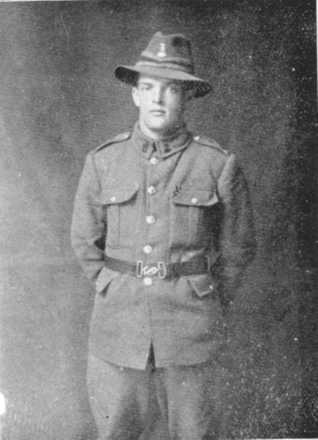Rfn
Brian Massey Hutchinson
Information about birth
|
Date of birth: 05/12/1896 |
|
Place of birth: Gisborne, Cook, New Zealand |
General information
|
Profession: Shepherd |
Army information
|
Country: New Zealand |
|
Force: New Zealand Expeditionary Force |
|
Rank: Rifleman |
|
Service number: 44284 |
|
Enlistment date: 06/12/1916 |
|
Enlistment place: Gisborne, Cook, New Zealand |
|
Units: — New Zealand Rifle Brigade, 1st Bn. (Last known unit) |
Information about death
|
Date of death: 03/12/1917 |
|
Place of death: Polderhoek, Belgium |
|
Cause of death: Killed in action (K.I.A.) |
|
Age: 20 |
Cemetery
|
Polygon Wood Cemetery Plot: Unknown Row: G Grave: 10 |
Distinctions and medals 2
|
British War Medal Medal |
|
Victory Medal Medal |
Points of interest 3
| #1 | Place of birth | ||
| #2 | Enlistment place | ||
| #3 | Place of death (approximate) |
My story
Brian Massey Hutchinson served in the 1st Battalion, 3rd New Zealand Rifle Brigade, New Zealand Division.
The New Zealand Division was in the Polygon Wood area, after the end of the Third Battle of Ypres. Much of the time was spent in wiring, repairing crumbling trenches and improving defences. The landscape was covered with waterlogged shellholes. The opposing German forces generally held higher ground and movement in the New Zealand lines was often observed and shelled or machine-gunned.
The Division relieved the 21st Division from 13th November, when the 3rd (NZ Rifle Brigade) and 4th NZ Infantry Brigades took over the front line. On 1st December the NZ Rifle Brigade relieved the 4th Infantry Brigade in the Becelaere Sector, with the 1st Battalion ( Brian’s unit) relieving the 3rd Otago Battalion. The brigade headquarters was at the Polygon Butte.
On 3 December part of 2nd Brigade attacked Polderhoek Chateau. The brigade history does not offer much detail on this period so it is difficult to say how Brian died on 3 December 1917. The entire terrain had been shelled to pieces, and the Reutelbeek, which flowed through the grounds, formed a wide area of marshland separating them from the ruins of the chateau. The ruins were in German hands. The Germans had pillboxes from which they could observe the British forces perfectly and fire at them. The attack of the 3rd December was carried out with the aim of taking the terrain as a whole and the task was given to the New Zealanders. The entire operation failed. Units were shelled by their own artillery because the guns sank into the mud so that, with their barrels pointing higher than intended, their shells fell short.
Strong wind made a smokescreen useless and the deployment of untrained troops contributed to the failure of the mission. Heavy losses at nearby Passchendaele had left the Allies with little choice but to send inexperienced reserve troops into battle. All the same, they fought unflinchingly.
Though not taking part in the attack, it is during the Battle of Polderhoek that Brian died. He was buried in Polygon Wood Cemetery, Row G, Grave 10.
The New Zealand Division was in the Polygon Wood area, after the end of the Third Battle of Ypres. Much of the time was spent in wiring, repairing crumbling trenches and improving defences. The landscape was covered with waterlogged shellholes. The opposing German forces generally held higher ground and movement in the New Zealand lines was often observed and shelled or machine-gunned.
The Division relieved the 21st Division from 13th November, when the 3rd (NZ Rifle Brigade) and 4th NZ Infantry Brigades took over the front line. On 1st December the NZ Rifle Brigade relieved the 4th Infantry Brigade in the Becelaere Sector, with the 1st Battalion ( Brian’s unit) relieving the 3rd Otago Battalion. The brigade headquarters was at the Polygon Butte.
On 3 December part of 2nd Brigade attacked Polderhoek Chateau. The brigade history does not offer much detail on this period so it is difficult to say how Brian died on 3 December 1917. The entire terrain had been shelled to pieces, and the Reutelbeek, which flowed through the grounds, formed a wide area of marshland separating them from the ruins of the chateau. The ruins were in German hands. The Germans had pillboxes from which they could observe the British forces perfectly and fire at them. The attack of the 3rd December was carried out with the aim of taking the terrain as a whole and the task was given to the New Zealanders. The entire operation failed. Units were shelled by their own artillery because the guns sank into the mud so that, with their barrels pointing higher than intended, their shells fell short.
Strong wind made a smokescreen useless and the deployment of untrained troops contributed to the failure of the mission. Heavy losses at nearby Passchendaele had left the Allies with little choice but to send inexperienced reserve troops into battle. All the same, they fought unflinchingly.
Though not taking part in the attack, it is during the Battle of Polderhoek that Brian died. He was buried in Polygon Wood Cemetery, Row G, Grave 10.
Sources 3
|
Archway https://www.archway.archives.govt.nz/FullItem.do;jsessionid=38130B821F7402BC87E8DF0B6878BBEC Sources used |
|
Austin W.S., The Official History of the New Zealand Rifle Brigade (The Earl of Liverpool's Own), (Uckfield, The Naval & Military Press Ltd., 2007), p 255 - 258. Sources used |
|
Stewart H., The New Zealand Division 1916-1919 : a popular history based on official records, (Auckland, Whitcombe and Tombs, 1921), p 306 -307 and p 310. Sources used |
More information 5
|
Commonwealth War Graves Commission Database https://www.cwgc.org/find-records/find-war-dead/casualty-details/480035 |
|
Namenlijst (In Flanders Fields Museum) https://namenlijst.org/publicsearch/#/person/_id=6805746a-7971-4f34-937c-a10ff5f209d5 |
|
Lives of the First World War (Imperial War Museum) https://livesofthefirstworldwar.iwm.org.uk/lifestory/7176901 |
|
The NZEF Project (UNSW Canberra) https://nzef.adfa.edu.au/showPerson?pid=125125 |
|
Online Cenotaph (Auckland Museum) https://www.aucklandmuseum.com/war-memorial/online-cenotaph/record/c7432 |
